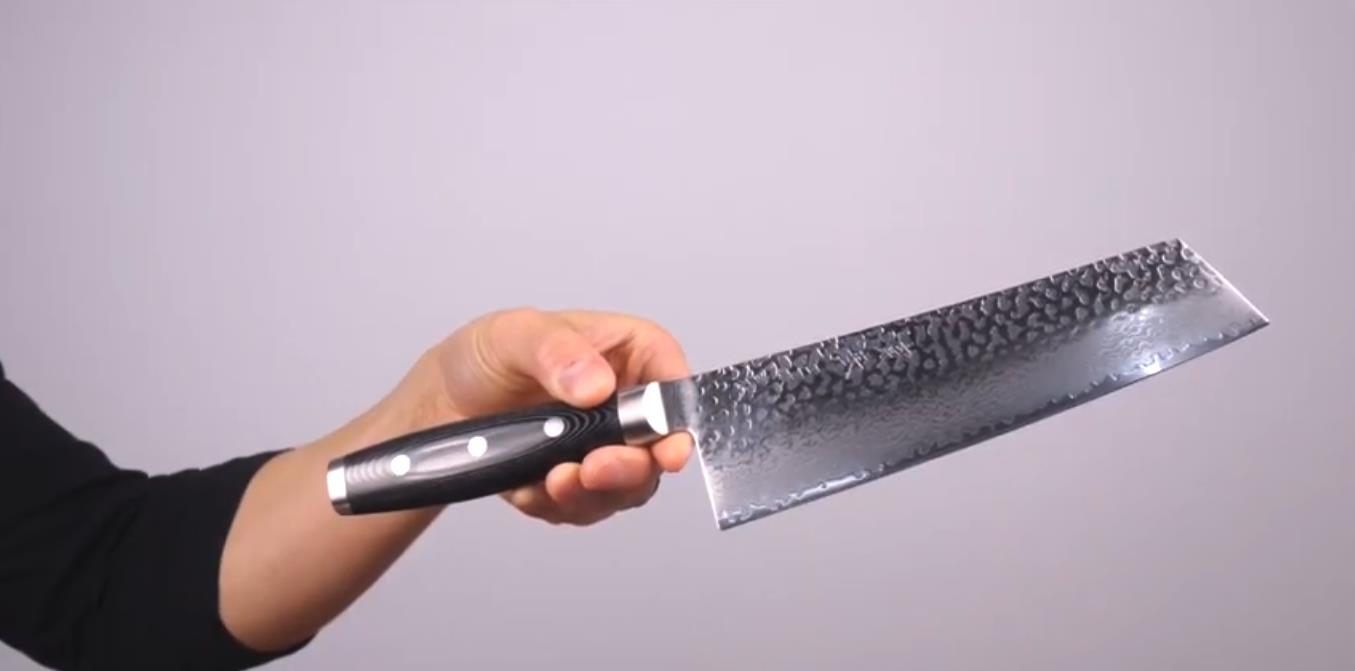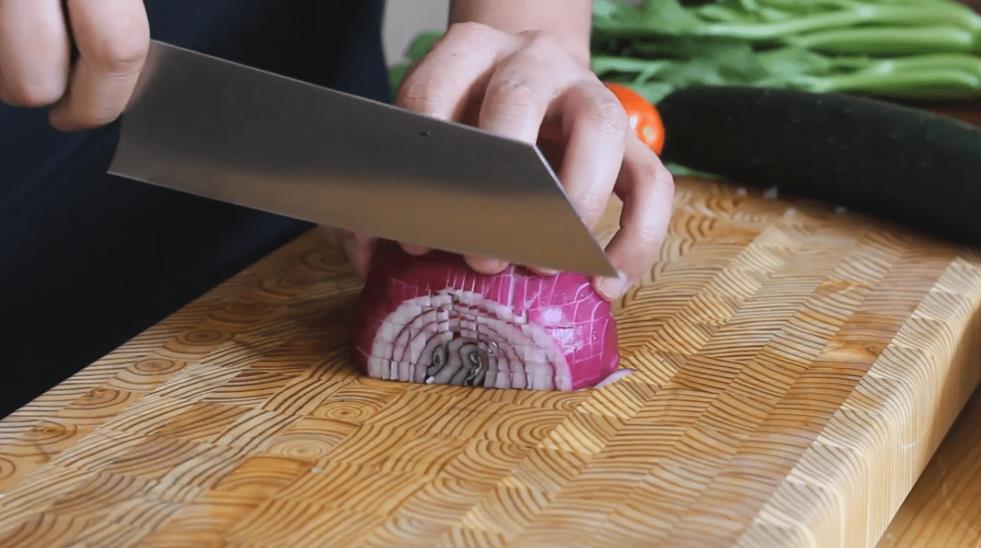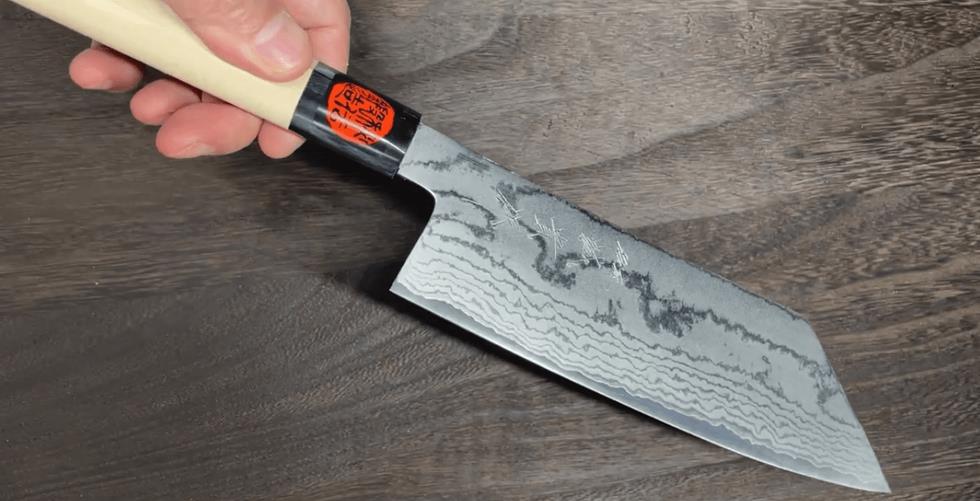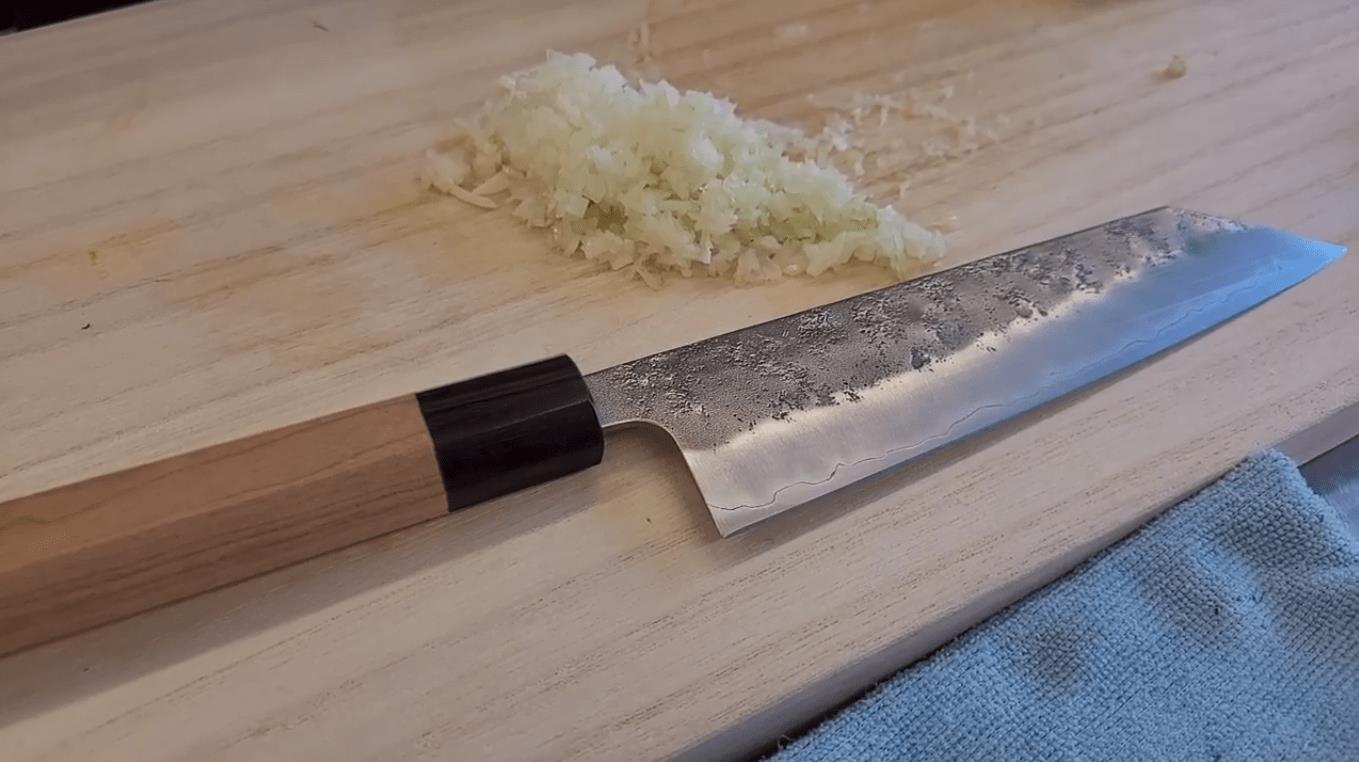Chefs looking to expand their kitchen knife collection will love the many gorgeous designs from Japan. Japanese cooking is famous for using specialized knives to prepare sushi, noodles, and other traditional dishes. Apart from these, there are several versatile knives for everyday kitchen tasks, including the santoku and gyuto. A somewhat less famous style is the bunka knife.
The bunka or bunka bocho is a Japanese all-purpose chef knife that shares physical characteristics with the santoku and kiritsuke styles. It has a relatively flat cutting edge with a very distinctive pointy tip. Like the majority of Japanese general-purpose blades, the bunka has a double bevel edge and can slice through most ingredients without trouble.
That was a short introduction to the bunka, but its name is probably still quite mysterious to you. It is a lesser-known Japanese style that you should become familiar with. The bunka is not only eye-catching but also a solid and compact knife that cuts very smoothly. Its build quality and performance in the kitchen can compete with most Japanese and western styles.
Table of contents
What is a bunka knife?

As we stated in the introduction, a bunka knife is a style of Japanese all-around kitchen knife. It is related to other Japanese all-purpose kitchen knives like the santoku, the gyuto, and the kiritsuke. This family of knives rivals equivalent European models (French, German, and Serbian chef knives). Like the santoku knife, the bunka has a short blade compared to other chef knives.
The name of this knife is interesting. In Japanese, “bunka” means “culture,” so bunka bocho translates to “cultural knife” or “cultured knife.” The deeper meaning of the name is not certain, but it could signify the importance of the bunka for preparing dishes central to Japanese culture. Or, it could mean that the bunka is a knife for people who understand great culture and taste. As we will see, this is a beautiful name for a beautiful knife.
Blade
Generally speaking, most bunka models have a very flat cutting edge with a small curve in the tip section. While the edge is typically flat, it is not horizontal relative to the handle and points upwards slightly.
On the other hand, the spine is completely flat and mostly horizontal until the end section, where there is a sharp kink. This is the tip where the spine angles down to meet the knife’s edge. The result is a sharp tip very similar to that of the kiritsuke.
This tip design is sometimes called a “reverse-tanto.” This is of course based on the traditional Japanese tanto sword with almost the same tip. The key difference is that the sword’s tip points upward rather than downward.
Edge
The bunka bocho is a double bevel knife, which is true of most all-around Japanese chef knives. A double bevel cutting edge is not as sharp as a single bevel version but is much more accessible for beginner cooks. The blade’s symmetry allows users to make straight and direct cuts with the knife instead of cutting diagonally.
Another benefit of having a double bevel edge is that you can use it no matter which hand you cook with. Plus, if produced from high carbon steel, the double bevel edge can be made very thin without losing any of its strength.
Handle
Most bunka knives on sale are made with wa handles. This is a design originating from Japan that consists of a slim cylinder of wood with a round or octagonal profile. This handle arrangement gives chefs a bit more sensitivity when preparing food.
Others may prefer western-style handles with scales, rivets, and finger grooves, for their comfort and visual appeal. Luckily, there are bunka knives with these handles as well.
Using a bunka knife
Cutting technique

The straight edge of the bunka is very good for vertical chopping motions. The edge lands perfectly flat on cutting boards so is very efficient at slicing through ingredients. You can use a very rapid tap chopping technique to mince meat, garlic, and onions. Unlike with some western chef knives, the lack of a curve in the bunka blade makes rock chopping difficult.
Chopping aside, the sharp and angled tip of the bunka is fantastic for scoring bread and for making very fine slices of fish and vegetables for sushi. The piercing power of the bunka can be utilized to remove tough skin from meat and fish.
Ingredients
The bunka has similar capabilities to other Japanese chef knives and is useful for preparing virtually the same ingredients. Meat, fish, vegetables, fruit, cakes, bread ― you name it. The bunka bocho is suitable for most tasks that you can imagine.
Just because the bunka is a Japanese design does not mean that it is limited to making Japanese dishes. Like we said, this tool can mince items like garlic, carrots, and onions. It can serve as a decent carving knife, sushi knife, bread knife, cheese knife, and paring knife too. In short, it offers excellent value for money.
How not to use it
Depending on the material of your bunka’s blade, you might want to avoid some foods. Carbon steel is not the most flexible material and, though strong, is at risk of snapping when cutting very tough foods.
Some tough meats will require lots of force to cut through. Doing so with a bunka knife can cause the blade to flex beyond its breaking point. However, since the bunka has a wider blade than the kiritsuke and gyuto, it will not bend as easily.
Using a bunka bocho to cut hard bones or shellfish is obviously not recommended as this could chip the blade.
Variations of the bunka knife

Ko bunka bocho
This is a style of bunka that is noticeably shorter than the standard version. This is obvious from the title alone; “ko” is the Japanese word for “small.” Most normal bunka knives have a blade 6-9 inches long, whereas the ko bunka’s blade may be as short as 4 inches. Nevertheless, it retains the same blade shape and design principles as the regular bunka.
The ko bunka can perform most of the tasks that the normal bunka can, but more accurately. Based on its size and agility, the ko bunka is a suitable replacement for a paring knife.
Hakata bocho
This style has minor differences from the regular bunka’s shape. The reverse tanto tip is still present on the hakata, but instead of having a flat spine, the spine curves slightly upward. The same is true of the cutting edge. Overall this has a more streamlined and less rigid appearance than the standard model.
Thanks to the curvature on the hakata’s blade, you can perform rock chopping motions far better than with a regular bunka.
Bunka knife vs santoku vs kiritsuke
| Bunka | Santoku | Kiritsuke | |
| Name meaning | “Cultural knife” | “Three virtues” | “Slice open” |
| Blade shape | A flat spine that angles down sharply to form a distinct point.The edge is flat with a slight curve in the tip section. | A spine that starts flat but curves dramatically in the tip section.The edge is mostly flat and the point is not extremely sharp. | Like the bunka, the kiritsuke has a flat spine with a very sharp reverse tanto tip.The kiritsuke’s blade is slimmer than the bunka’s. |
| Blade length | 6-9”Smaller models can have 4-5” blades. | 5-8” | 9-12” |
| Bevel | Double | Double | Usually single |
| Suitable for | All users | All users | More experienced chefs |
Japanese all-purpose knives vs western all-purpose knives
Size
By design, Japanese chef knives tend to be a little shorter and/or slimmer than their western equivalents. The bunka and santoku are known for being short and easy to handle. The closest equivalent to a western knife from Japan is a gyuto which is essentially a slimmer version of the standard western design.
The western styles are generally longer but still convenient to use. Western all-purpose knives can have varying widths. Notably, German chef knives are wider than French styles.
Blade shape
In standard French or German chef knives, their blades have mostly flat spines with edges that curve gradually from the base of the blade to the tip. This is a pleasant design that is recognized around the world. The curved edges are great for rock chopping ingredients.
The Japanese all-purpose knives have quite varied blade shapes. The standard bunka and kiritsuke have flat spines with very defined points, while the santoku knife has a curved spine and a less sharp point. These three knives all have quite flat edges that do not roll well on a cutting board. The gyuto is separate from these styles and greatly resembles the western shape.
Blade material
There is no single material used to make Japanese or western blades, though traditional Japanese knives were and still are forged from high carbon steel. Japanese models are widely available in stainless steel (and ceramics too) nowadays, though the premium knives are always hand-forged with carbon steel.
In European kitchens, stainless steel is often the material of choice. Both types of steel have their advantages and disadvantages.
Bevel
Historically, Japanese swords always had a single bevel edge. This feature was adopted by craftsmen when making kitchen knives too. Some specialized knives like the usuba and yanagiba retain the single bevel edge for maximum sharpness.
General-purpose Japanese knives like the bunka and santoku have double bevel edges which make using and maintaining them much easier. The kiritsuke is a more advanced knife with a single bevel.
Western chef knives always have double bevel edges.
Do you need a bunka knife?
Anybody who spends their time a lot from the kitchen call for a chef knife. People with smaller hands or those who prefer knives with a more compact build will benefit from owning a bunka or santoku.
Yet, you must remember that the bunka is just one type of chef knife. Nobody needs a bunka specifically because there is nothing it can do that other chef knives can’t. Therefore, the decision to buy a bunka (or not) depends on how much you like the design.
Even if you have decided to purchase a bunka knife, there are numerous models on the market to choose from. Hence, you still have decisions to make regarding the knife’s variation, material, and handle.
How to choose a bunka knife

Variation
The standard bunka bocho is the sensible choice for most people and is the easiest to find. More manufacturers sell this style, so you can find regular bunka knives at various prices to suit most budgets. Of the three variations mentioned in this article, the regular bunka is the most versatile because it combines elements from the santoku and kiritsuke styles.
If you prefer to use a rock chopping motion when cutting but still love the look of a bunka, you can search for a hakata. This variation is not very easy to find, so you might need to pay a little more to own one.
As for the ko bunka, this is not a great long-term replacement for a chef knife and is only a good option for precise tasks.
Blade material
The question of the best blade material has no definite right or wrong answer. It is partly a practical choice and partly aesthetic. Those who like a shiny and flexible blade should opt for stainless steel, while those who like a harder and more traditional-looking knife should choose high carbon steel. Of course, each has physical disadvantages: stainless steel will wear out faster and carbon steel may rust sooner.
When picking a material, you need to consider the properties of the metal as well as how it looks.
Handle
Once again, the best handle depends entirely on the user. Choosing a wooden wa handle means giving up some comfort. Nonetheless, some chefs love the sensitivity that the wa handle offers in addition to its authentic appearance.
Selecting a western-style handle with scales and rivets does not mean you are losing the Japanese craftsmanship. Some would argue that a Japanese knife with a western handle is the perfect fusion of east and west. With this setup, you can have the familiarity and comfort of a western grip while enjoying the precision and sharpness of a Japanese blade.
Neither handle is a bad choice.
Which all-purpose knife do you like most?
To cook better and enjoy nicer meals, you need the optimum equipment ― a chef knife should be your top priority. After reading the previous sections, you hopefully have an idea of your favorite all-purpose knife.
If you still cannot decide, perhaps you will find something you like in our store.









